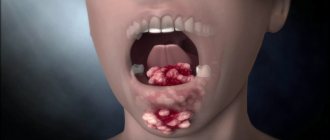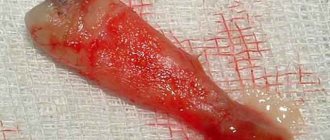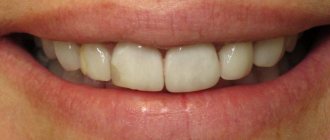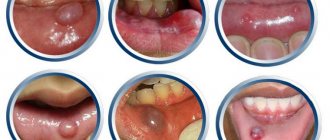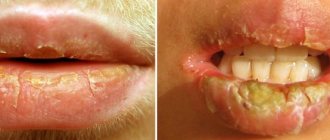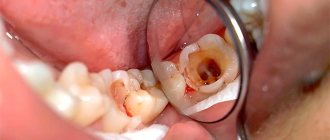Lip cancer is a rapidly growing neoplasm that develops from squamous epithelial cells of the lower or upper lip. The disease is easy to miss in the initial stages of development. The advanced stage cannot be treated, the person suffers, and health deteriorates. It is important not to miss the onset of the disease and urgently take measures for cure. The disease has an ICD-10 code C00.
Rapidly spreading, cancer cells infect healthy organs located near the lesion. The process of influencing the affected areas with dosage forms and surgical interventions is difficult. The prognosis for survival in the initial stages of the disease is high. With the highest degree of cancer, positive treatment becomes unlikely.
It is worth considering the location of the cancer site. A person often looks in the mirror. This becomes an undeniable advantage for quickly recognizing the body’s signal about organ disease. Statistics show: in 100% of cases of disease, 98% are lesions on the lower lip, the remaining 2% belong to diseases of the upper lip. Cancer appears on the lower lip more often. Cancer of the upper lip is rather an exception to the rule of oncological phenomena. In medicine this is called casuistry.
Cancer as a disease
It is important to understand what kind of disease cancer is. The name is familiar to an adult. Why oncological failure occurs in the body is a phenomenon unfamiliar to many.
Considering the body as a system, we see that organs consist of cells and connective tissues. A certain type of cell forms the tissue that forms the organ.
Looking at the structure of the lip, it is clear that the upper layer consists of flat cells that are in a set sequence. As the disease develops, the integrity of the structure is disrupted, and some cells are modified. Changing externally, they change the internal composition, a completely different metabolism develops, and resistance to external factors is impaired. Affected cells do not tolerate any climatic change in the environment: cold, heat, radiation. Next, a genetic deviation occurs, the cell begins to rapidly divide. This is squamous cell carcinoma. Statistics in medicine indicate that men are more likely to get cancer.
Lip cancer
Treatment in Belgium
In clinics in Belgium, for oncological pathologies such as lip cancer, treatment is concentrated on preserving the patient’s quality of life after surgical or therapeutic removal of the tumor.
For this purpose, innovative treatment methods are being introduced into clinical practice, with the help of which it is possible to remove the tumor and preserve the functional and aesthetic parameters of the lips.
Hyperfractionated radiotherapy
This is a type of radiation therapy in which the total dose of radiation is divided into smaller fractional doses, and treatment sessions are carried out more than once a day. This approach makes it possible to reduce radiation damage to healthy tissue and avoid complications such as radiation necrosis and mucositis.
Local chemotherapy
Chemotherapy is a cancer treatment that uses drugs to stop the growth of cancer cells by killing the cells or stopping the cells from dividing. When chemotherapy is taken orally or injected into a vein or muscle, the drugs enter the general bloodstream and have systemic toxic side effects in addition to treating cancer cells. As a result, the dosage of the therapeutic agent must be strictly limited.
With regional chemotherapy, drugs are injected directly into the tumor and primarily affect cancer cells. This is more effective, since the dosage of the drug in the tumor can be maximum.
Hyperthermic therapy
Hyperthermia therapy is a treatment in which body tissue is heated above normal temperature to damage and kill cancer cells or to make cancer cells more sensitive to the effects of radiation and certain cancer drugs.
Experimental biological treatment
As part of clinical research programs in oncology clinics in Belgium, studies are being conducted on the local effect on basal cell carcinoma and squamous cell carcinoma of a complex of the genetically modified T-VEC virus and an intracellular chemical therapeutic agent.
Complex functional and aesthetic reconstructive facial plastic surgery
Aesthetic and reconstructive surgeons in multidisciplinary treatment centers in Belgium are present in the medical team already at the planning stage of tumor removal surgery. This makes it easier for them to plan their own surgery for functional and aesthetic reconstruction, which improves the quality of the recovery and makes it less traumatic.
Negative interference in the body
By changing the ongoing metabolism, diseased cells produce toxic substances. Close interaction with a healthy cell of a healthy organ leads to its damage. Any human organ can be affected: heart, kidneys, liver, lymph nodes. Infection of important vital organs leads to death from cancer. Patients who have the last stage of cancer, are already sufficiently affected by oncology, will not be able to get out of the disease on their own. With serious organ damage, patients die.
The destructive effect during spread impairs the immune system. The body stops responding quickly to the invasion of active, painful microbes and frequent acute respiratory viral infections begin, even if this has never happened before.
Reasons why lip diseases develop
Human lips are very vulnerable, which often leads to redness, irritation, dryness, and even the formation of wounds and crusts. Most often, cheilitis develops under the influence of external factors : low temperature, wind, sunlight. Under their influence, the skin around the mouth dries out, which in itself is unpleasant. If you don't do anything about it, the problem will only get worse.
The second factor that causes lip diseases is various allergens. The culprit of the pathological reaction can be both food and cosmetics. Problems in the functioning of the internal systems of the body can also affect the face.
Most often, the delicate skin around the mouth suffers due to hormonal imbalances, fungal and viral infections. Vitamin deficiency, indigestion and general deterioration of immunity can aggravate the situation.
There are also less common causes of lip disease. They usually lead to certain types of cheilitis.
Causes of the disease
There are precursors to the disease that indirectly cause destructive damage. A person who is inattentive to health has an impact on undermining his vitality. Ecology and all sorts of ailments that were not treated at the time are superimposed. It is chronic processes in the body that often serve as an impetus for the development of cancer. Here is an approximate list of reasons when a person is exposed to cancer cells:
- Regular infectious lesions of the lower lip (inflammation of the border, damage to the mucous membrane or skin of the lips by bacterial and viral microorganisms).
- An incorrect bite, a sharpened edge of a carious tooth, unsuitable dentures - anything that causes mechanical damage to the lip.
- Thermal or chemical effects, incl. from alcohol, from snus or from eating hot food.
- An imprint of a profession in hazardous work (working with harmful substances, heavy metals, vapors of alkalis, acids and poisons).
- Exposure to the environment (frequent climate change, aggressive tanning, hypothermia or overheating).
- Heredity.
Initial symptoms of lip cancer
The listed causes of cancer negatively affect human health. The way to minimize the occurrence of the disease is to provide timely support to the body in the form of preventive measures:
- observe safety precautions in the workplace;
- use protective cosmetics;
- eliminate harmful addictions to alcohol;
- give up cigarettes;
- reduce mechanical stress.
Causes
The causes of lip cancer are often chronic inflammatory processes. A tumor on the lower lip can be caused by the following factors:
- regular infections
- permanent mechanical damage,
- chemical or thermal injuries,
- frequent contact with heavy metal compounds and other chemical vapors,
- climatic conditions - frequent changes in the natural environment.
There is a high probability that lip cancer is possible from smoking, excessive alcohol consumption, and regular consumption of hot food. These factors do not directly cause cancer; exposure to carcinogenic compounds can contribute to the development of optimal conditions for the oncological process. That is why, for prevention purposes, it is better to quit bad habits, for example, smoking or drinking alcohol.
Statistics for cancer of the lower lip do not exclude the influence of genetic inheritance. If one of your relatives has already had cancer, this can be considered a significant risk factor for the appearance of a tumor.
Precancerous conditions
The reasons listed above only scratch the surface of the possibilities for cancer. There are known diseases that are later confused with cancer. The statistics are as follows: diseases that are not directly the source of the disease lead to cancer if left untreated. With this prognosis, there is a 100% probability that the emerging pathology will develop into cancer.
Such diseases are called obligate diseases. Only through constant therapy and a competent approach to treatment is there a chance of slowing down the process or completely eliminating it. But only when regular preventive measures are carried out.
Diseases after which the risk of malignant tumors developing into tumors are high have been identified. They are called facultative precancer.
It is worth familiarizing yourself with the diseases mentioned in more detail.
Obligate precancer
The subgroup includes three diseases that almost always progress to the stage of cancer:
Manganotti cheilitis manifestation
- Haylit Manganotti. Regular occurrence of erosion on the lips of a pale pink hue. Red color is possible. The appearance of external signs lasts up to several months, then they disappear on their own from the surface of the lips. Ulcerative formations do not increase pain, the sensitivity of the lips remains at the same level. There is no focal redness, bleeding is excluded. People live with such minor external signs, but the disease returns once every 1-3 months. In those who continue to smoke, the development of lesions is more common.
- Limited hyperkeratosis. It looks like a concave or curved lesion of gray scales of horny plates. The size of the lesion is 1.5 cm, the shape is irregular. When exposed to the damaged layer, bleeding of the epithelium occurs. However, they are difficult to separate from the affected area. A doctor will help you recognize the disease.
- Warty precancer. Small hemispherical nodules, reaching 9 mm, the border of which is red or pale pink, protruding above the surface of the lip. The epithelium is externally unchanged, palpation of the affected area is painless. When the scales are abundant, the color becomes gray.
Thanks to the bright external manifestations, it is quite easy to find out what disease has struck you. Diagnosis is carried out and appropriate treatment is prescribed.
Optional precancer
A broad subgroup that allows possible damage by cancer cells. Diseases include:
- Chronic cheilitis is an inflammatory process that affects the mucous membrane and skin of the lip. Duration: from two months. The reasons why the disease occurs: allergic reactions, bacterial or viral damage, fungus.
- Radiation stomatitis is a severe form of damage to the alveolar processes in the oral mucosa. Reason: radio radiation that occurs during professional interaction with various types of rays, jaw injuries, after radiation therapy. It does not appear with strong immunity. The detection of the disease occurs when the body’s protective function decreases.
- Leukoplakia is a lesion of the oral mucosa, where the squamous epithelium becomes keratinized. The following symptom appears: pain when chewing, redness, swelling, bleeding gums. The transition to the cancer stage reaches 20%.
- Papilloma is a benign tumor, round in shape with a small protrusion. The color palette remains unchanged. When interacting with saliva, it acquires a whitish or gray tint.
- Keratoacanthoma is a benign oval-shaped tumor with a small ulcer in the central part. It disappears on its own after a few months, leaving behind a small scar.
Keratoacanthoma of the lip
Looking at the list of listed diseases, we can see that benign tumors are included in the list, which indicates the likelihood of developing from positive dynamics into a malignant disease. This type of rash should not be ignored, even if it disappears on its own over time! During the examination, the clinic will be able to identify a malignant tumor.
How to diagnose cancer early?
To diagnose any complex disease at its early stage, it is necessary to periodically make preventive visits to your doctor. As mentioned above, if you detect any injuries, cracks, or formations on the surface of the lips, you must consult a doctor. This is especially true if the course of the disease is accompanied by painful sensations.
Remember that you cannot independently diagnose the disease based on external signs alone. Only an experienced specialist, after a thorough examination, a series of procedures and tests, can make his verdict. A scraping is taken from the affected surface to examine the epithelial cells. Test results will not be available immediately. The patient will have to be patient to wait for the doctor's verdict. In any case, already during this period, it is necessary to direct all efforts to quit smoking.
Symptoms of the disease
When cancer cells first spread, symptoms appear at the initial stage: the patient’s general well-being worsens. He experiences weakness, loses appetite, and loses a little weight. A headache appears, accompanied by a temperature within 38 degrees.
As soon as the first signs appear, changes at the external level begin to appear, indicating intoxication in the body. Such tumors appear within a few weeks or months.
Initially, the affected area appears covered with a gray crust. A slight elevation indicates lip hardening. The initial stages are painless, the tissues remain unchanged.
Getting rid of the gray crust will indicate focal bumps of different sizes. They are visible to the naked eye and are firmly fused with the lip.
Skipping the onset stage without applying the necessary treatment leads to the development and spread of cancer cells. The latter increase in size, covering a large area of the lip, affecting the surrounding tissues. The appearance will resemble a tightly twisted knot. New symptoms of the disease begin: pain, itching and difficulty eating. The pain becomes of varying intensity, tenderness appears on palpation. If irritability from itching and difficulty eating, the patient begins to eat food carefully so as not to injure the affected area.
An additional external manifestation will be cell necrosis. Outwardly it looks like an ulcer, with uneven edges and a depression in the center. Pain on palpation persists. The lump extends to the chin or cheek.
As the disease deepens, damage to the lymph nodes of the chin, neck and back of the head begins, and the spread of metastases covers nearby healthy organs. The entry of infected cells will subsequently lead to disruption of the organ and affect the functioning of the body.
Swollen lip in an adult: causes and treatment
Lips swell for a variety of reasons, so establishing the nature of this phenomenon on your own is quite problematic.
Injury
Lip injuries are common among boxers. But even people who are far from practicing martial arts are not immune from blows and other injuries, after which the lip may swell:
Photo: jammed
bruise - from a fall, impact;- biting teeth - accidental or due to orthodontic defects, neurological pathologies, grinding teeth in sleep, habit of biting nails;
- tattoo or piercing – the possibility of infection of the wound surface;
- burn of the lip from the inside or outside by hot food, steam or sunlight;
- cracks and jams - with internal pathologies, biting and chapping;
- dental procedures - accidental injury to areas of the lips inside the oral cavity with dentist instruments during dental treatment, a reaction to surgical intervention when cutting the frenulum.
If a traumatic factor causes a sudden increase in volume, thickening, or blueness of the lip, but the skin remains unharmed, it is necessary to apply ice to the sore spot as quickly as possible. The ice cube must be wrapped in cloth or gauze to avoid hypothermia.
Ice compresses are applied to the site of swelling for 10–15 minutes every 2–3 hours in the first two days after injury. This is usually enough to significantly reduce swelling on the lip and reduce pain.
Absorbable ointments, for example, Badyaga, Rescuer, and folk remedies - aloe lotions, bags of cooled tea leaves, chamomile or oak bark decoction will finally help cure swelling. If the swelling does not subside after a few days, it is better to see a doctor.
In case of an open injury, when after a blow not only the upper or lower lip is sharply swollen, but also tissue rupture occurs, you urgently need to rinse the wound with hydrogen peroxide to clean it of germs and stop the bleeding. Then you need to treat the damaged area with a disinfectant, for example, Dioxidin. This treatment should be done every 2-3 hours until bleeding occurs.
If the lip is deeply damaged, especially if the frenulum is affected, the victim should contact a traumatologist as soon as possible to disinfect the wound and, if necessary, apply sutures.
Dental problems
With some diseases of the teeth and gums, as well as during their treatment, the lips may swell, both from the inside and the outside. Against the background of pain in the teeth of the lower jaw, the lower lip may swell due to:
- caries;
- stomatitis;
- periodontitis;
- periodontal disease;
- periostitis;
- phlegmon;
- flux;
- abscess.
With similar processes in the upper jaw, the upper lip sometimes swells and swells.
The cause of lip swelling can be the treatment of dental diseases: accidental injury with an instrument, a reaction to the administration of an anesthetic, or swelling after complex surgical interventions in the oral cavity.
Another option for why the upper lip hurts, turns red and swells may be associated with a visit not to the dentist, but to a cosmetologist for the purpose of injection lip augmentation. Damage to a blood vessel as a result of an unsuccessful injection can lead to a hematoma with swelling. An individual reaction of the body to the administered drug is also possible.
Allergic reaction
Redness and swelling of the lip are a common symptom of allergies. The body can react in this way to a variety of allergens:
- plant pollen;
- food ingredients;
- components of medicines, cosmetics and perfumes;
- insect bites;
- household chemicals.
Photo: allergies
As soon as it becomes clear that your lips are swollen due to allergies, you need to take an antihistamine as quickly as possible. Any allergic swelling on the face is dangerous because it can spread towards the throat. This is how life-threatening angioedema develops. Therefore, your home medicine cabinet must contain some kind of drug to combat allergies:
- Diazolin.
- Suprastin.
- Tavegil.
- Zodak.
- Fenistil.
- Claritin.
- Clarotadine.
- Diphenhydramine.
- Erius.
If your lip is suddenly swollen due to an allergy, you should urgently take an age-appropriate dose of one of these medications and consult a doctor. Allergic reactions are especially dangerous for children, so if a small patient is injured, you should call an ambulance.
You can eliminate lip swelling and get rid of itching with the help of non-hormonal ointments and topical gels with antihistamine action: Fenistil-gel, Vitaon, Nezulin, Psilo-balm.
Herpetic infection
Photo: herpes
Failure of the immune system can occur in every person due to hypothermia, viral infection, stress or overwork. And the result of this failure often manifests itself in the form of a herpetic rash that suddenly forms on the lips under the nose.
If the upper lip is swollen and covered with blisters, it means that the herpes virus has become active in the body. Ointments based on acyclovir will help relieve the symptoms of the disease. At the same time, you can be treated in a traditional way - lubricate the swollen areas of tissue in the area of the nasolabial triangle with tea tree oil, diluted celandine juice or propolis tincture.
If herpetic blisters spread widely and the inflammatory process begins, drug treatment is necessary, which should be prescribed by a doctor.
Herpes can cause serious complications, since the infection spreads not only to the skin of the face and mucous membrane of the oral cavity, but also to internal organs. During the period of exacerbation of the disease, everything must be done to prevent the addition of a bacterial infection. It is necessary to disinfect the affected areas of the facial skin with antiseptics (Chlorhexidine, Miramistin) carefully, avoiding opening pimples and pustules.
Four stages of cancer
Cancerous tumors in medicine are divided into four stages. Stage classification indicates the lesions and spread to other organs. When making a diagnosis, doctors use an abbreviation, the formation of which comes from the stage of the oncological lesion itself, taking into account the nature of the tumor. In medicine, certain symbolism is accepted. For example, cancer of the lower lip stage II TNM. This letter and number designation indicates a malignant tumor, where the first letter is the size of the damaged area, the second is the damage to the lymph nodes, and the third is the presence of metastases.
The size of the tumor is equal to a parameter from 1 to 4. An indicator reaching 3 (i.e. T3) indicates damage to the tissue of the lips, while T4 is significant damage covering the lips and nearby organs: jaw, part of the tongue, pharynx.
With the indicator of lymph node damage, 4 stages will also be determined, starting from 0. Where 0 – no node damage; 1 – slight increase within 3 cm; 2 – the size of the lesion in one place is acceptable up to 6 cm, or in several areas also within 6 cm; 3 – significant enlargement of the lymph nodes, exceeding the size of 6 cm.
Metastases are not qualified; the following designation is accepted: M0 – absence of metastases, or simply the letter M – presence of metastases.
After assigning each letter an indicator, an analysis is performed and the stage of cancer is determined:
- the initial (first stage) has the abbreviation – T1N0M0;
- second stage – T2N0M0;
- third stage – T3N0M0 or T1-3N1M0;
- fourth stage – T4N0M0 or T1-4N2-3M0, or T1-4N0-3M1.
Given the different classification of cancer stages, the doctor prescribes different types of treatment. The prognosis for recovery depends on the stage of cancer. Various modern examinations help establish the correct stage of a malignant tumor.
Symptoms
Symptoms of cancer are divided into two main groups - the first signs of lip cancer, which are manifested by a general deterioration of the patient’s condition, and signs that directly relate to the lips.
The first group includes the following:
- weakness and fatigue,
- sudden loss of body weight,
- hyperthermia.
The first symptoms of lip cancer can manifest themselves in different ways, depending on the stage of the disease:
- the lip becomes larger in size,
- the presence of a seal under the skin of the lip,
- swelling can be detected on the cheek on the side of the neoplasm,
- salivation increases,
- unpleasant odor from the mouth,
- mucous membranes begin to turn blue,
- at certain stages of tumor progression, the function of the lower jaw is impaired,
- the initial stage of lip cancer can cause hoarseness,
- at the last stage, a sore throat and pain appear, which indicates damage to the lymph nodes.
Before the appearance of specific cancer symptoms, this form of oncology has the following symptoms:
- the appearance of a small tubercle with a dark brown tint,
- minor pain syndrome,
- burning and itching, which can cause significant discomfort while eating.
Metastasis is directed to the nearest lymph nodes. In the case of lesions of the upper lip, the spread depends on the immediate location of the tumor. Symptoms at the initial stage are almost invisible, and all the signs can easily be confused with ordinary herpes. But if there is uncontrolled flow of saliva, you should immediately be examined in a hospital. Studies of the morphology of cells and tissues prove that all these signs indicate the presence of a progressive disease, so if they appear, it is worth undergoing an examination.
Diagnosis of a malignant tumor
Detection of a tumor is not always possible without the use of modern medical devices. In this case, laboratory tests are carried out to confirm or refute the suspected diagnosis.
Laboratory research
The first thing the doctor will do after the final conversation with the patient is send the patient for tests. A diagnosis cannot be made without this. There are two possible scenarios.
Cytology
The well-known method is cytological examination, a standard method actively used by doctors. The essence of the method is that affected cells are taken from the patient, stained with a special composition and examined under a microscope at very high magnification. With long-term observation, you can notice active division of the cellular composition, and the “appearance” is different from a healthy cell, then most likely the diagnosis will be confirmed.
The collection of the studied material is carried out in several ways: scraping, puncture (in this case the affected area is pierced and the necessary biomaterial is suctioned), cutting of the affected tissue. The method of collecting material is determined by a specialist. The chosen method does not affect laboratory analysis. With any sampling of material, the result is always determined.
Biomarkers
As noted, malignant cancer begins with an internal mutation with the release of various types of intoxications. Thanks to this factor, it is possible to establish a diagnosis when taking a blood test for laboratory tests. And although this method is not as popular as cytology, it is used as an additional method to the first laboratory examination. Biomarkers are not often used in medicine due to their high cost and the likelihood of errors during examination. But together with cytology, the doctor will be able to more accurately determine the disease.
A biological marker with an established disease detects P53 and KI-67.
Making a diagnosis using medical equipment
The fastest and most accessible method is to study a malignant tumor using special equipment. Used to pinpoint affected areas. There are a number of types of diagnostics.
X-ray
The fastest and most accessible method that indicates possible damage to bone tissue. And although the accuracy of the determination is lower than CT, it is actively used due to its low price. At stage 4, a darkened affected area with an irregular shape is clearly visible, which begins to diverge in different directions, indicating the growth and proliferation of cancer cells.
Computed tomography or magnetic resonance imaging
Accurate identification of the affected area in a specific area. MRI is better suited to detect cancer in soft tissue damage. If there are changes in the bone structure, CT will provide clearer data.
The CT method allows us to examine the structure of the tissues in the layer based on X-ray images, while the MRI method determines the lesion by exposure to nuclear magnetic resonance.
Fluorescence assessment
To make a diagnosis, this method uses a device that uses waves of different frequencies to find and diagnose damaged areas. The method is harmless to humans and is quite accurate in determining the disease. But, unfortunately, it is little used in Russia.
Diagnosis of lip cancer
A tumor on the lower lip can be detected with the naked eye, but for the diagnosis to become reliable, it must be confirmed by laboratory research methods. The spread of the tumor, the presence of metastases and damage to the lymph nodes can be studied using instrumental diagnostics.
Laboratory diagnostics
Cytological examination
Until now, this method is the “gold standard” in diagnosing any cancer. Its principle is simple - you need to take a sample of cells from a suspicious area, stain them and look at them under a microscope. If they differ from normal or their excessive division is observed, this is reliable confirmation of the cancerous nature of the disease.
There are several methods for collecting cells: scraping, puncture (puncture and aspiration), thin section with a scalpel or conchotome, etc. The preferred method is determined individually by the oncologist.
Biomarker research
Cancer cells secrete special chemicals that can be detected in the patient's blood. This method is used much less frequently than the cytological method, since it is expensive and not accurate enough (the probability of error is 15-24%). As a rule, biomarkers are examined if it is impossible to look at the cells under a microscope or the doctor still has doubts about the correctness of the diagnosis.
Markers P53 and KI-67 are specific for lip cancer.
Instrumental diagnostics
X-ray of the lower jaw
The most accessible method that allows you to assess the presence/absence of cancer growth into the bone. Its accuracy is significantly lower than that of CT, but due to its low price it has become widespread. With T4, on a targeted image you can see a darkened focus of irregular shape. As a rule, it fan-shapedly diverges in different directions - this is a characteristic sign of cancerous growth.
CT, MRI scan of the face and neck area
These research methods allow you to accurately assess the spread of cancer in a specified area. Using MRI, soft tissue damage (tongue, pharynx, lymph nodes, etc.) is assessed. A CT scan can better identify changes in the bones.
Fluorescence diagnostics
A modern method for assessing tumor growth. Using a special device that emits waves of a certain frequency, suspicious tissues are studied. The method is absolutely safe; there is no irradiation of humans. It is comparable in accuracy to MRI or CT. Disadvantage: low prevalence in the Russian Federation.
Treatment of a malignant tumor
Different stages of the tumor determine different courses of treatment prescribed by the doctor. There are several types of effects on the affected areas to prevent the spread of the tumor to healthy cells and organs:
- radiation therapy;
- laser destruction;
- electrocoagulation;
- cryodestruction;
- surgery;
- photodynamic treatment;
- local use of antitumor drugs.
Despite the seriousness of the disease, drug treatment is prescribed at the first stage, or as support and relief of pain symptoms in conjunction with other types of therapy. Targeted treatment is prescribed in the absence of affected lymph nodes, metastases and minor damage to nearby tissues. Otherwise, the patient is prescribed a course of chemotherapy.
Cryodestruction
Technology for destroying diseased cells by exposing them to a cold air stream at low temperatures. Thanks to this treatment, the affected cells begin to disintegrate and stop reproducing. Next, the doctor removes the affected area without touching healthy tissue. Such precision will reduce the risk of recurrent lesions and improve the patient's condition.
Radiation therapy
Exposure to the affected area using radiation. This treatment prevents the affected cells from spreading to the lymph nodes. Most often, after radiation therapy, surgery is used to remove dead areas. Accurate targeting of the beam to a malignant tumor makes it possible to prevent its further spread.
Laser destruction
Quick, painless removal of malignant cells using a guided laser. The method has been used relatively recently, but has already firmly entered into practicing medicine. There are practically no contraindications for laser therapy. Rapid action removes diseased cells from the human body in a matter of minutes.
Electrocoagulation
Impact of high-frequency electric current on the tumor. High temperatures cause tissue burns, while separating the healthy layer from the affected surface. This method is more preferable if it is planned to send the obtained biomaterial for further laboratory examination.
Working with an electrocoagulator
Photodynamic therapy
The treatment method is often used due to its effectiveness and safety for the patient’s body. To influence the tumor, a drug with ultraviolet radiation is used - a photosensitizer, then the radiation source is directed, and oxygen access to the painful area is created.
The method is free of side effects. Thanks to ultraviolet exposure, recurrence of the lesion is minimized.
Considering the high cost of the method, its application is small; not everyone can afford such expensive treatment.
Chemotherapy
If the tumor spreads, targeted treatment will not bring the desired result. Therefore, in the later stages of the disease, the doctor prescribes chemotherapy for the body. The principle of action is based on the correct selection of medications that will be aimed at supporting the patient’s condition, as well as stopping the spread of cancer cells.
Treatment
After the diagnosis has been made, the doctor prescribes treatment based on all the information collected, in particular, the treatment method is selected depending on the stage of progression of the disease. Treatment of lip cancer should be aimed at the tumor and the suspected area of metastasis.
Treatment can be carried out in the following ways:
- radiation therapy,
- cryogenic method,
- photodynamic method,
- chemotherapy,
- plastic.
The sooner treatment is started, the better the prognosis for recovery. In advanced cases, it is possible to perform a Crail operation to remove the cervical lymph nodes.
Radiation therapy
The technique is based on the effect of radiation on the lymph nodes in the neck and the affected area. This is the most effective method of therapy, even in rare cases where cancer of the upper lip is observed. Radiation therapy can stop metastasis by preventing damage to the lymph nodes.
Folk remedies
Treatment of lip cancer with traditional medicine can be carried out using medicinal plants, for example, birch mushroom, burdock root or beetroot.
But it is important to understand that traditional medicine is just an addition to drug treatment. Only in this case is the expected result from the use of folk remedies possible.
Preventive measures
According to statistics, older people suffer from lip cancer; middle-aged people are less likely to suffer from lip cancer. At the same time, despite the decrease in incidence, lip cancer remains in 8th place among cancer lesions.
To reduce malignant neoplasms in the body, you should be attentive to your health, regularly visit the doctor’s office, and give up smoking and alcohol. Regular oral hygiene and reducing intense sun exposure will also reduce the risk of developing the disease. Timely treatment of any damage to the lip tissue reduces the occurrence of tumors several times.
First signs
In the first stages of tumor formation, the tumor does not cause any discomfort. Minor redness of the lip can easily be confused with a symptom of a weakened immune system when a pimple appears on its surface, reminiscent of a herpetic rash. Despite the vagueness of the symptoms, it is necessary to pay attention to these first signs of lip cancer, namely:
- periodic sensation of itching and burning in the same part of the surface of the lip, which lasts 10-15 minutes and then suddenly goes away;
- redness of the epithelial surface, having a rich purple tint;
- slight pain while eating, worsening when food touches the painful area of the oral cavity;
- increased salivation, which occurs both during feeding and without obvious reasons;
- the appearance of a tubercle on the lip, which very quickly increases in size, and then also intensively transforms into an ulcerative formation, which does not have clearly defined boundaries due to its constant growth in diameter;
- enlargement of the submandibular lymph nodes, when there are no concomitant inflammatory processes in the body (especially in the throat area).
what the initial stage of lip cancer looks like in the photo
These are signs of the primary stage, which progresses very quickly. From the moment the inflamed tubercle degenerates into an ulcer, metastasis of cancer cells begins in the surrounding epidermal tissues and rapid destruction of the cellular structure of the lip. It becomes motionless and seems to merge with the front part of the lower jaw. Regular eating becomes very difficult, since the oral cavity does not actually close.
Depending on the activity of the patient’s immune cells, the tumor can affect epidermal and bone tissue located in a circle within a few months, or develop over years.
Disease prediction
In the first stages, cancer can be successfully treated. Even if the stage of the lesion reaches level 3, there is a chance to cure the insidious disease by using all modern methods. At the same time, the recurrence of a malignant tumor does not reach 40%.
When stage 4 is advanced, doctors rarely manage to save the patient. Unfortunately, like all cancer pathologies, lip cancer is fatal due to damage to vital organs. The doctor’s task at this stage is to alleviate the condition and help the patient by following clinical recommendations.
Diagnostics
Diagnosing the disease in the early stages makes it possible to ensure that the disease is completely stopped and its development is prevented. What diagnostic methods are used for lip cancer?
Diagnostic methods used to determine lip cancer and its stage can be roughly represented by the following list:
- External examination of the affected lip and mucous membrane is used as the initial diagnostic method. For this purpose, a magnifying glass can be used to examine the surface of the skin in more detail;
- palpation - allows you to determine the degree of pain and the release of ichor or pus from existing ulcers;
- a piece of tissue is taken for examination - this method is called a biopsy;
- X-ray examination of the lymph nodes of the neck and skull;
- Ultrasound of the patient’s abdominal and thoracic organs, sometimes dental x-rays are taken.
For a more detailed study, a biopsy of the lymph nodes of the neck and a cytological puncture are performed.
After diagnosis, after analyzing the general condition of the patient, a treatment method is prescribed that will quickly stop the development of the disease.
Causes and risk factors for developing lip cancer
When treating cancer abroad, it has long been known that the exact cause of cancer is still unclear, but certain risk factors are associated with specific types of cancer. The risk factors for lip cancer are the same as those for oral cancer. These include:
- Smoking and tobacco use . Smoking and tobacco are the most commonly associated factors in the treatment of lip and oral cavity cancer. Cigarettes contain various carcinogens, including tar. Chemicals found in cigarettes damage the lining of the lip, causing abnormal cells to multiply. Almost all patients suffering from lip cancer are smokers.
- Alcohol consumption . Drinking alcohol leads to the penetration of DNA-damaging substances into the cells of the lip and mouth. When alcohol is combined with smoking, there is a higher risk of developing lip cancer.
- Exposure to the sun . Exposure to harmful ultraviolet radiation from the sun for long periods can cause skin cancer, including lip cancer.
- HPV infection . Warts caused by human papillomavirus (HPV) may contribute to the development of lip cancer. HPV usually affects the vagina, penis, and cervix. The practice of certain sexual practices contributes to the spread of the virus in the lips and mouth.
- Chronic irritation . Lip irritations caused by poor fittings and other dental appliances can cause changes in the cells of the mouth and lips.
- Lack of vegetables and fruits . These foods have antioxidant properties, and it is believed that a lack of these substances in the diet may predispose people to lip cancer. Considering that the lack of these substances in the body affects not only the development of oncology, attention should be paid to this factor.
- Male . Men have a higher percentage of smokers and alcoholics, which predispose the male population to oral cancer.
- Age over 40 years . Adults over age 40 have a higher risk due to greater exposure to carcinogens and ultraviolet rays.
Here are the logical ways to prevent lip cancer:
- Quitting smoking and tobacco use.
- Moderate consumption of alcoholic beverages.
- Avoiding unsafe sexual practices such as oral sex.
- Avoiding prolonged exposure to the sun, especially between 10:00 and 15:00 hours, to prevent exposure to harmful ultraviolet rays. Apply sunscreen to your lips.
- Include fruits and vegetables in your diet and consider taking vitamin supplements.
How does a cigarette affect the development of cancer?
We already know the answer to the question of whether lip cancer will occur if you do not smoke. But how does a cigarette affect the development of this pathology?
According to statistics, a smoker smokes about ten cigarettes every day. During the smoking process, the paper in which the tobacco is wrapped comes into contact with the lips, where the skin is very delicate and sensitive. Over time, microcracks form on the surface of the skin, which are difficult to see; in addition, they do not cause pain or discomfort. Tobacco smoke begins to actively affect the damaged epithelium, toxins and carcinogens enter the tissues. They promote the transformation of healthy cells into cancer cells.
At first, the pathological process proceeds unnoticed, but over time, the pathology begins to manifest itself in the form of pain, and then other symptoms. Therefore, even if you don’t smoke heavily, lip cancer will occur; of course, this does not always happen.
Doctors say that any tobacco product has the same negative impact on health if used regularly. There is no organ in the human body that does not suffer from tobacco smoke.
How to find out prices for lip cancer treatment in Israel?
Given the popularity of cancer treatment in Israel, today many patients with various diagnoses want to know the prices for cancer treatment abroad. This interest is due to the fact that people want more and more effective treatment of any of their diseases using the most modern methods and progressive medications. This is exactly what is available to patients in foreign medical centers. Many patients choose lip cancer treatment in Israel.
However, you should understand that it will be impossible to find out the exact price of treatment before arriving at the clinic. This is purely a preliminary figure.
To do this you need:
- Fill out the contact form on the website.
- After a very short time, the patient will be contacted by a medical coordinator to find out additional information.
- At the request of the coordinator, it will be necessary to send all medical documents, extracts, and test results related to the problem available to the patient.
- Based on the results of reviewing the submitted papers, the patient can be contacted by a specialized oncologist who will ask a number of clarifying questions about the patient’s condition, diagnosis, problems and his wishes regarding treatment.
- As a result of the work done, medical consultants will select for the patient several options for clinics and medical centers where his problem is best solved. Then the choice is up to the person.
